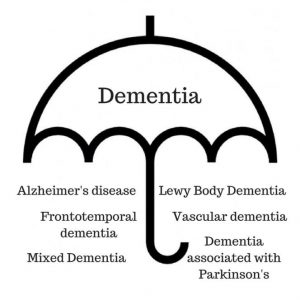Learning the Basics of Dementia
One of the most frequent questions I receive from families, caregivers, or person with memory loss is “What is the difference between dementia and Alzheimer’s disease?” This concept can be a little confusing, especially in the midst of a recent diagnosis. This article will help explain this common question, as well as go into some basic information about Alzheimer’s disease and other types of dementia.
Think of dementia as an “umbrella word”. Dementia itself describes a set of symptoms (memory loss, confusion, judgment impairment, cognition challenges, etc.). Under the “umbrella” of dementia, there are many different types or forms of dementia. Alzheimer’s disease is the most common form of dementia, making up over 60% of all dementia diagnoses. Some other common forms of dementia include Lewy Body Dementia, Frontotemporal Dementia, Mixed Dementia, Vascular Dementia, and Dementia associated with Parkinson’s disease.
Alzheimer’s is a progressive dementia, meaning that a person’s functioning declines over a number of years. Although the disease is highly individual, on average, Alzheimer’s can last between 10-12 years.
Alzheimer’s itself has several key warning signs/symptoms that a person may notice in the early stages of the disease before diagnosis. Close family and friends may also notice some of these symptoms and encourage their loved one to see guidance from their physician or a specialist such a neurologist or geriatrician. Although Alzheimer’s disease affects each person individually, there is a common set of warning signs. If you or a loved one are experiencing any of the warning signs below, it is a good time to see a specialist to determine a specific diagnosis.
- Changes in mood and/or personality
- Memory loss that interferes with daily life
- Difficulty completing familiar tasks
- Withdrawal from regular activities
- Impaired judgment
- Challenges in planning or solving problems
- Difficulty with language
- Delayed processing time
- Communication deficits
- Confusion
- Difficulty with math and finances
Although Alzheimer’s disease is the most common form of dementia, it is helpful to know the other common forms of dementia.
Both Dementia with Lewy Bodies and Parkinson’s disease dementia are classified under the category of Lewy Body Dementia. In addition to the impairment of cognition, there may also be physical changes such as tremors and movement challenges. Hallucinations are also a common symptom associated with these types of dementia.
Vascular dementia is typically caused by cardiovascular disorders such as stroke or other chronic conditions that affect blood flow to the brain. Symptoms can often depend on where damage occurred in the brain due to reduced blood flow.
Frontotemporal dementia (FTD) is marked by degeneration in a person’s frontal lobe of their brain. There are three main types of frontotemporal dementia that have different main symptoms. The first is behavior variant FTD which presents primarily as changes in behavior and personality. The second is primary progressive aphasia which affects language and communication. The last type of FTD is disturbance of motor function that can be present with or without the behavior variant and primary progressive aphasia types. FTD primarily affects adults in their 40-60s, but can occur throughout the entire life span.
Mixed dementia can be a combination of dementias. The most common form of mixed dementia is Alzheimer’s disease and vascular dementia. For diagnosis of mixed dementia, a physician carefully reviews all symptoms that are occurring and tries to determine if there are distinct features of more than one type of dementia.
Adapted from Alzheimer’s Association, Lewy Body Dementia Association



